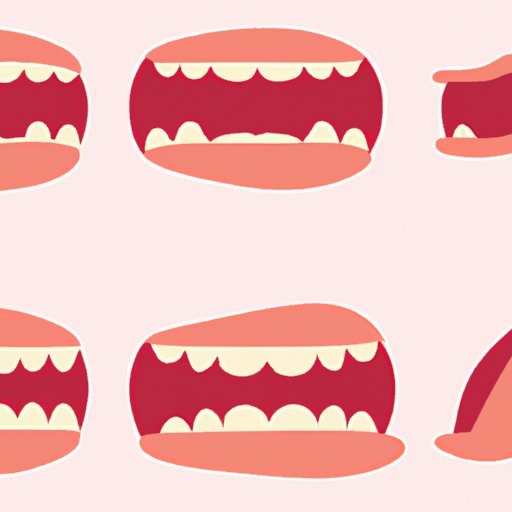
I. Introduction
Animated mouths are an essential element of any animated character. They help bring the character to life and convey emotions, moods, and personality. Drawing and animating mouths can be challenging, but with the right guidance, anyone can learn. In this article, we will provide a step-by-step guide on how to draw an animated mouth, from the basic structure to adding details, shading, and expressions. Whether you are an aspiring animator, artist, or just curious, this article will benefit you.
II. Step-by-Step Guide to Drawing Animated Mouths
Before drawing an animated mouth, it’s crucial to understand the structure and movement of the mouth when speaking. The mouth consists of the upper and lower lips, teeth, tongue, and gums. When speaking, the mouth moves in different ways depending on the sound being produced.
To draw a basic mouth shape, begin by sketching a curved line for the upper lip and a curved line for the lower lip. The distance between the two lines determines the mouth size. Next, draw two vertical lines in the center of the mouth for the teeth. Then, add the tongue and gums. Finally, erase unnecessary lines and add shading for a more realistic look.
Adding shading and details can make the mouth look more lifelike. Use light and shadow to create depth and texture. Pay attention to the form and shape of the lips, teeth, and tongue. The final result should be a well-proportioned and anatomically correct mouth.
III. Mastering the Art of Mouth Animation: Tips and Tricks
Mouth animation is an essential aspect of animating characters. To create believable mouth movements, timing, exaggeration, and accents are crucial. Timing refers to the speed and rhythm of the mouth movements, making them match the dialogue. Exaggeration can enhance the character’s personality and emotions, but it’s essential not to overdo it. Accents can add emphasis and variation to the character’s speech.
There are different styles of mouth animation, such as cartoon and realistic. Cartoon mouths tend to be exaggerated and expressive, while realistic mouths are more subtle and natural. Understanding the style of the animation will help create appropriate mouth movements.
To make the mouth movements match the dialogue, it’s essential to pay attention to the sounds and syllables. Different mouth shapes match different sounds, such as vowels, consonants, and lip trills. Practice and observation can help master the art of mouth animation.
IV. Drawing Expressive Mouths for Your Animated Characters
The mouth can convey a wide range of emotions and moods in animation. Happy, sad, angry, surprised, and scared are some of the emotions that can be portrayed through the mouth. To draw expressive mouths, it’s essential to pay attention to the shape of the lips, teeth, and tongue.
Happy mouths tend to be wide and upturned, with visible upper teeth. Sad mouths are usually downturned, with a closed mouth. Angry mouths are tight and narrow, with visible bottom teeth. Surprised mouths are round and open, with visible upper and bottom teeth. Scared mouths are tense and narrow, with lips pressed together.
It’s essential not to over-exaggerate emotions to maintain a natural look. Small details can make a big difference, such as wrinkles around the lips and corners of the mouth.
V. Unlock Your Creativity: Drawing Different Types of Animated Mouths
Mouths come in different shapes and sizes, depending on the character. Human, animal, creature, and fantasy are some of the types of mouths that can be drawn. Drawing unique mouth shapes can make the character more interesting.
When drawing animal and creature mouths, it’s crucial to pay attention to the anatomy and characteristics of the particular animal or creature. For example, a dog’s mouth is different from a cat’s mouth, and a dragon’s mouth is different from a wolf’s mouth.
Adding textures, patterns, and colors can enhance the uniqueness of the mouth shape. Experimentation and creativity can unlock endless possibilities.
VI. Animating Words: How to Draw Mouths for Lip Syncing
Lip syncing is the process of matching the mouth movements with the sounds of the dialogue. It’s essential to make the mouth movements look natural and in sync with the audio.
When drawing mouths for lip syncing, pay attention to the sounds and syllables being spoken. Different sounds require different mouth shapes, and the mouth movements should be accurately synchronized.
It’s essential not to rely solely on lip syncing to convey emotions and expressions. The mouth movements should match the character’s overall movement and body language.
VII. Drawing Mouth Movements: Bringing Your Animated Characters to Life
Mouth movements play a significant role in bringing animated characters to life. Fluid and natural mouth movements can enhance the character’s personality and emotions.
To draw natural mouth movements, pay attention to the timing and speed of the movements. The mouth should move in a fluid and continuous motion, with a gradual opening and closing. The jaw and tongue movements should also be taken into account.
Observation and reference can help create realistic mouth movements. Paying attention to real-life situations and conversations can provide useful insights.
VIII. Conclusion
Drawing animated mouths can be challenging, but with practice and patience, anyone can learn. Understanding the structure and movement of the mouth, adding details and shading, and mastering mouth animation, are all crucial elements to creating believable and expressive mouth movements. Drawing different types of animated mouths and unlocking creativity can lead to unique and interesting character designs. Lip syncing and natural mouth movements can enhance the character’s personality and emotions.
We encourage you to practice drawing and animating mouths and experiment with different styles and techniques. There are numerous resources available, such as tutorials, books, and online courses, to help improve your skills.




